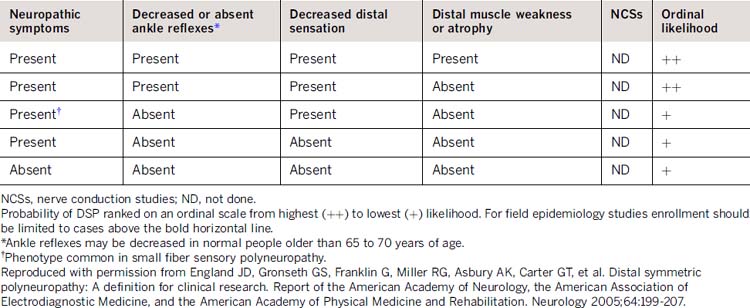Table 74-2 Estimated likelihood of distal symmetric polyneuropathy for case definitions that include only symptoms and signs: recommendations for field or epidemiologic studies

In order to clarify the case definition, a few essential points are necessary. The literature indicates the following: (1) Neuropathic symptoms alone have low diagnostic accuracy for polyneuropathy; (2) neurologic signs are better predictors of polyneuropathy; (3) multiple neurologic signs are more sensitive than single neurologic signs for the diagnosis of polyneuropathy; (4) NCSs are included in the case definition because they are objective and validated tests of peripheral nerve function. Abnormal NCSs increase the likelihood of the presence of polyneuropathy and increase the specificity of the case definition.4–8 However, NCSs are not used by themselves to make the diagnosis of polyneuropathy because they do not have perfect sensitivity and specificity.
For research studies, patient selection should probably be restricted to cases that meet the highest likelihood of polyneuropathy (i.e., the highest specificity). For clinical research studies, this consists of those patients who meet a likelihood of ++++ (see Table 74-1). NCSs are not required for field or epidemiologic studies (see Table 74-2), but the likelihood of diagnosis must be accordingly downgraded.
Limitations of the case definition
This case definition has major limitations for generalization, mainly because the definition is based on only 12 articles.5,7–17 Although 61 articles were reviewed, only these 12 attained a grade higher than Class IV. According to AAN guidelines, only Class I, II, and III articles may be used in evidence-based analysis.18 These articles were heavily weighted toward DSP associated with diabetes mellitus and characterized by predominant involvement of large fibers. The other articles studied cryptogenic sensory DSP.
How well the case definition describes DSP of other etiologies is uncertain and will require further testing. The case definition will certainly require refinement as it is tested in other varieties of DSP. The case definition is not designed or “intended to emphasize the subset of distal symmetric polyneuropathy termed small fiber polyneuropathy.”1 There is still controversy regarding the best definition of small-fiber polyneuropathy. Although quantitative sensory testing, autonomic testing, and skin biopsy are being used in various settings, at the time that this case definition was written, the evidence in the literature did not allow a clear conclusion about how these tests should be incorporated into the case definition for DSP. As the validated literature and routine availability of these tests grows, they could easily be incorporated into the case definition for DSP. Moreover, the refined case definition could then be expanded to include a formal subset case definition that is specific for small fiber polyneuropathy.
Stay updated, free articles. Join our Telegram channel

Full access? Get Clinical Tree








